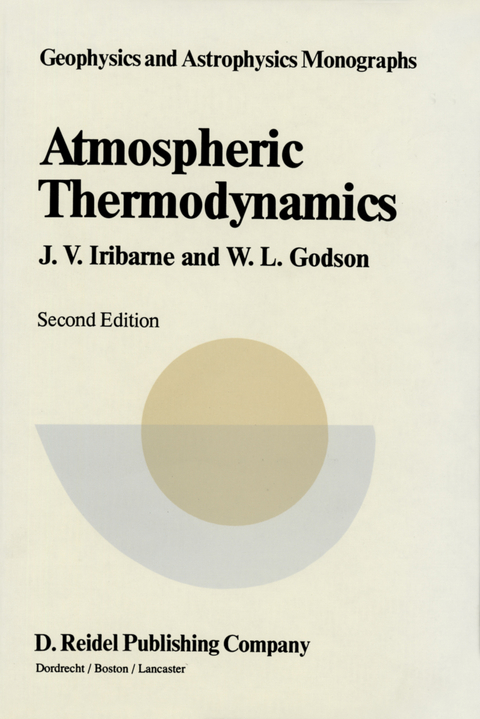
Atmospheric Thermodynamics
Kluwer Academic Publishers (Verlag)
978-90-277-1296-7 (ISBN)
I. Review of Basic Concepts and Systems of Units.- 1.1 Systems.- 1.2 Properties.- 1.3 Composition and State of a System.- 1.4 Equilibrium.- 1.5 Temperature. Temperature Scales.- 1.6 Systems of Units.- 1.7 Work of Expansion.- 1.8 Modifications and Processes. Reversibility.- 1.9 State Variables and State Functions. Equation of State.- 1.10 Equation of State for Gases.- 1.11 Mixture of Ideal Gases.- 1.12 Atmospheric Air Composition.- Problems.- II. The First Principle of Thermodynamics.- 2.1. Internal Energy.- 2.2 Heat.- 2.3 The First Principle. Enthalpy.- 2.4 Expressions of Q. Heat Capacities.- 2.5 Calculation of Internal Energy and Enthalpy.- 2.6 Latent Heats of Pure Substances. Kirchhoff’s Equation.- 2.7 Adiabatic Processes in Ideal Gases. Potential Temperature.- 2.8 Polytropic Processes.- Problems.- III. The Second Principle of Thermodynamics.- 3.1 The Entropy.- 3.2 Thermodynamic Scale of Absolute Temperature.- 3.3 Formulations of the Second Principle.- 3.4 Lord Kelvin’s and Clausius’ Statements of the Second Principle.- 3.5 Joint Mathematical Expressions of the First and Second Principles. Thermodynamic Potentials.- 3.6 Equilibrium Conditions and the Sense of Natural Processes.- 3.7 Calculation of Entropy.- 3.8 Thermodynamic Equations of State. Calculation of Internal Energy and Enthalpy.- 3.9 Thermodynamic Functions of Ideal Gases.- 3.10 Entropy of Mixing for Ideal Gases.- 3.11 Difference Between Heat Capacities at Constant Pressure and at Constant Volume.- Problems.- IV. Water-Air Systems.- 4.1 Heterogeneous Systems.- 4.2 Fundamental Equations for Open Systems.- 4.3 Equations for the Heterogeneous System. Internal Equilibrium.- 4.4 Summary of Basic Formulas for Heterogeneous Systems.- 4.5 Number of Independent Variables.- 4.6 Phase-Transition Equilibria forWater.- 4.7 Thermodynamic Surface for Water Substance.- 4.8 Clausius-Clapeyron Equation.- 4.9 Variation of Latent Heat Along the Equilibrium Curve.- 4.10 Water Vapor and Moist Air.- 4.11 Humidity Variables.- 4.12 Heat Capacities of Moist Air.- 4.13 Moist Air Adiabats.- 4.14 Enthalpy, Internal Energy and Entropy of Moist Air and of a Cloud.- Problems.- V. Equilibrium with Small Droplets and Crystals.- 5.1 Vapor Pressure of Small Droplets of a Pure Substance.- 5.2 Vapor Pressure of Solution Droplets.- 5.3 Sublimation and Freezing of Small Crystals.- Problems.- VI. Aerological Diagrams.- 6.1 Purpose of Aerological Diagrams and Selection of Coordinates.- 6.2 Clapeyron Diagram.- 6.3 Tephigram.- 6.4 Curves for Saturated Adiabatic Expansion. Relative Orientation of Fundamental Lines.- 6.5 Emagram or Neuhoff Diagram.- 6.6 Refsdal Diagram.- 6.7 Pseudoadiabatic or Stüve Diagram.- 6.8 Area Equivalence.- 6.9 Summary of Diagrams.- 6.10 Determination of Mixing Ratio from the Relative Humidity.- 6.11 Area Computation and Energy Integrals.- Problems.- VII. Thermodynamic Processes in the Atmosphere.- 7.1 Isobaric Cooling. Dew and Frost Points.- 7.2 Condensation in the Atmosphere by Isobaric Cooling.- 7.3 Adiabatic Isobaric (Isenthalpic) Processes. Equivalent and Wet-Bulb Temperatures.- 7.4 Adiabatic Isobaric Mixing (Horizontal Mixing) Without Condensation.- 7.5 Adiabatic Isobaric Mixing with Condensation.- 7.6 Adiabatic Expansion in the Atmosphere.- 7.7 Saturation of Air by Adiabatic Ascent.- 7.8 Reversible Saturated Adiabatic Process.- 7.9 Pseudoadiabatic Process.- 7.10 Effect of Freezing in a Cloud.- 7.11 Polytropic Expansion.- 7.12 Vertical Mixing.- 7.13 Pseudo- or Adiabatic Equivalent and Wet-Bulb Temperatures.- 7.14 Summary of Temperature and Humidity Parameters. ConservativeProperties.- Problems.- VIII. Atmospheric Statics.- 8.1 The Geopotential Field.- 8.2 The Hydrostatic Equation.- 8.3 Equipotential and Isobaric Surfaces. Dynamic and Geopotential Height.- 8.4 Thermal Gradients.- 8.5 Constant-Lapse-Rate Atmospheres.- 8.6 Atmosphere of Homogeneous Density.- 8.7 Dry-Adiabatic Atmosphere.- 8.8 Isothermal Atmosphere.- 8.9 Standard Atmosphere.- 8.10 Altimeter.- 8.11 Integration of the Hydrostatic Equation.- Problems.- IX. Vertical Stability.- 9.1 The Parcel Method.- 9.2 Stability Criteria.- 9.3 Lapse Rates for Atmospheric Ascents.- 9.4 The Lapse Rates of the Parcel and of the Environment.- 9.5 Stability Criteria for Adiabatic Processes.- 9.6 Conditional Instability.- 9.7 Oscillations in a Stable Layer.- 9.8 The Layer Method for Analyzing Stability.- 9.9 Entrainment.- 9.10 Potential or Convective Instability.- 9.11 Processes Producing Stability Changes for Dry Air.- 9.12 Stability Parameters of Saturated and Unsaturated Air, and Their Time Changes.- 9.13 Radiative Processes and Their Thermodynamic Consequences.- 9.14 Maximum Rate of Precipitation.- 9.15 Internal and Potential Energy in the Atmosphere.- 9.16 Internal and Potential Energy of a Layer with Constant Lapse Rate.- 9.17 Margules’ Calculations on Overturning of Air Masses.- 9.18 Transformations of a Layer with Constant Lapse Rate.- 9.19 The Available Potential Energy.- Problems.- Appendix I: Table of Physical constants.- Answers to Problems.
| Reihe/Serie | Geophysics and Astrophysics Monographs ; 6 |
|---|---|
| Zusatzinfo | XV, 260 p. |
| Verlagsort | Dordrecht |
| Sprache | englisch |
| Maße | 178 x 254 mm |
| Themenwelt | Naturwissenschaften ► Geowissenschaften ► Geologie |
| Naturwissenschaften ► Geowissenschaften ► Meteorologie / Klimatologie | |
| ISBN-10 | 90-277-1296-4 / 9027712964 |
| ISBN-13 | 978-90-277-1296-7 / 9789027712967 |
| Zustand | Neuware |
| Informationen gemäß Produktsicherheitsverordnung (GPSR) | |
| Haben Sie eine Frage zum Produkt? |
aus dem Bereich


